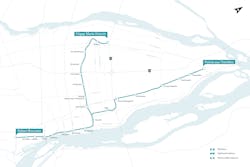CDPQ Infra to build C$10-billion REM light-rail project in Montréal’s east end
Caisse de dépôt et placement du Québec, through its CDPQ Infra subsidiary, plans to build a 32-km (19.8-mile) Réseau express métropolitain (REM) light-rail project on the east end of Montréal, Quebec. CDPQ Infra says the project, REM de l’Est, is in coordination with the government of Québec and city of Montréal.
The proposed light-rail project would be build in two branches, which would merge toward downtown Montréal and connect the east side of the city to Rivière-des-Prairies – Pointe-aux-Trembles, Montréal-Nord, Saint-Léonard, Rosemont-Petite-Patrie, Mercier-Hochelaga-Maisonneuve and Ville-Marie.
“Thanks to the innovative spirit and world-class expertise of our teams in developing major infrastructure projects, we are putting forward a public transit system proposal that meets both the needs of our six million depositors and the need for mobility in the eastern and northeastern sectors of the island. This is a sustainable investment that will contribute to Quebecers’ retirement plans and generate significant benefits for the economy, the environment and communities. At CDPQ, we call this constructive capital, since it allows us to combine performance and progress,” said Caisse de dépôt et placement du Québec President and CEO Charles Emond.
The project would include 23 new stations and represent a C$10-billion (US$7.85-billion) investment from CDPQ. It would connect with the REM project already under construction to form a 99-km (61.5-mile) light-rail network with a total of 49 stations. CDPQ says at full build out, the REM network would be one of the largest automated transit networks in the world.
REM de l'Est is expected to draw more than 133,000 users per day to its “high-quality transit service” that will connect employment, education and health centers.
“The arrival of this mobility solution is an opportunity to create user-friendly facilities, develop neighborhoods on a human scale and reclaim the banks of the St. Lawrence River. It will transform the nature of transit in Montréal’s east end with time savings of up to 70 percent, while bringing neighborhoods closer together and accelerating the revitalization of this vast territory with enormous potential,” said CDPQ Infra Managing Director Jean-Marc Arbaud.
CDPQ notes the elevated structure and stations will receive special attention in their architectural treatment “to ensure they endow downtown Montréal with a modern and symbolic aesthetic.”
The company will collaborate with the city on an advisory committee where recommendations can be submitted to maximize the architectural integration into the communities along the route.
"This project has the potential to transform mobility in the east and northeast of the metropolis and to become a formidable engine for economic recovery. This new access to downtown public transit will open up horizons for several Montréal neighborhoods, including Pointe-aux-Trembles, Montréal-Nord, Saint-Léonard and Mercier-Hochelaga-Maisonneuve. In order to make it a real lever for urban redevelopment, the urban integration and architectural signature will have to be exemplary. The REM de l'Est will have to be an architectural success, both on board and around the train," said Mayor of Montréal Valérie Plante.
The proposed project will be presented to the public and relevant authorities during the coming weeks. Additionally, REM de l’Est will be submitted to the Bureau d'audiences publiques sur l'environnement (BAPE) for review as early as 2021.
About the Author

Mischa Wanek-Libman
Group Editorial Director
Mischa Wanek-Libman is director of communications with Transdev North America. She has more than 20 years of experience working in the transportation industry covering construction projects, engineering challenges, transit and rail operations and best practices.
Wanek-Libman has held top editorial positions at freight rail and public transportation business-to-business publications including as editor-in-chief and editorial director of Mass Transit from 2018-2024. She has been recognized for editorial excellence through her individual work, as well as for collaborative content.
She is an active member of the American Public Transportation Association's Marketing and Communications Committee and served 14 years as a Board Observer on the National Railroad Construction and Maintenance Association (NRC) Board of Directors.
She is a graduate of Drake University in Des Moines, Iowa, where she earned a Bachelor of Arts degree in Journalism and Mass Communication.

